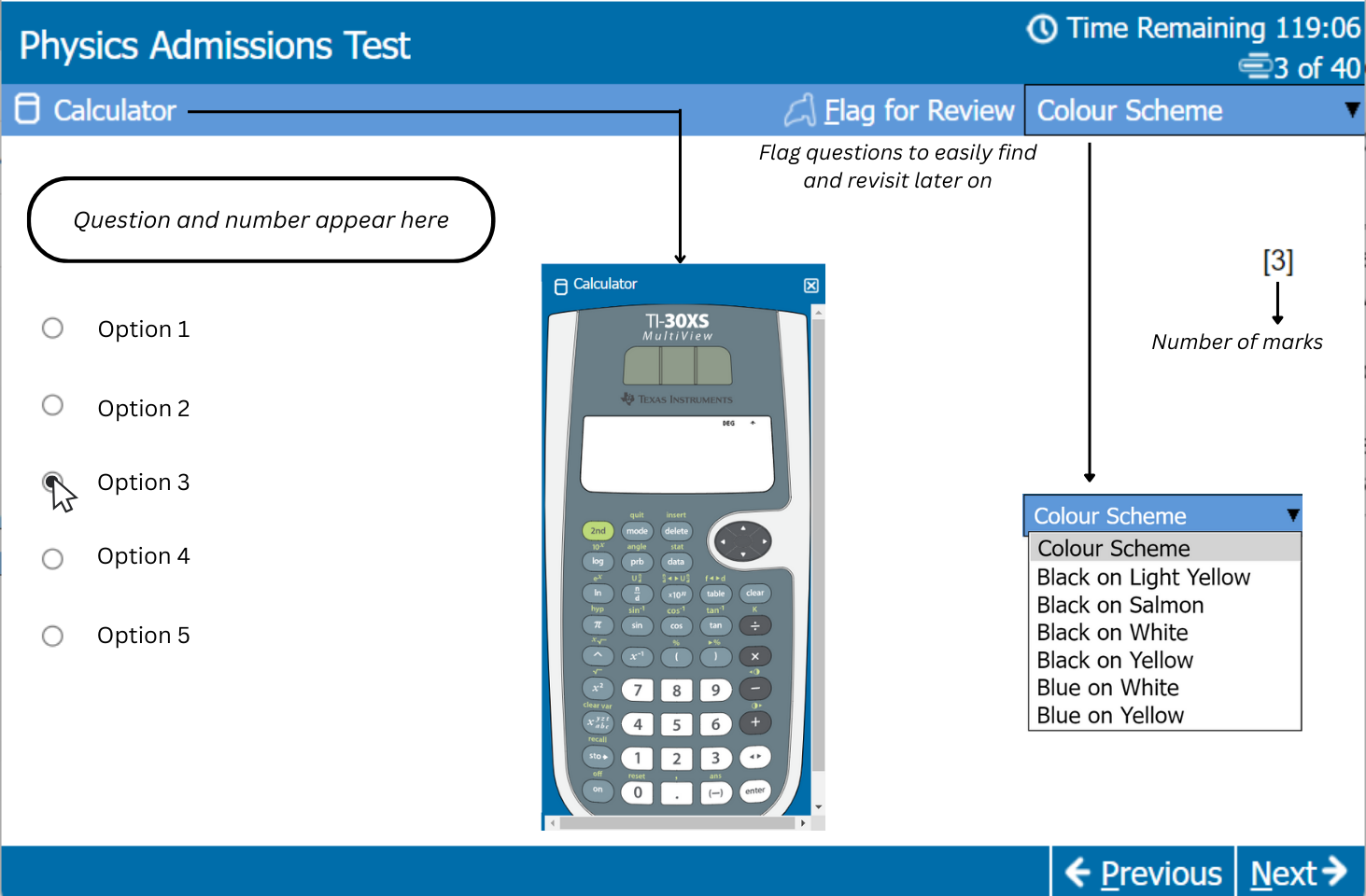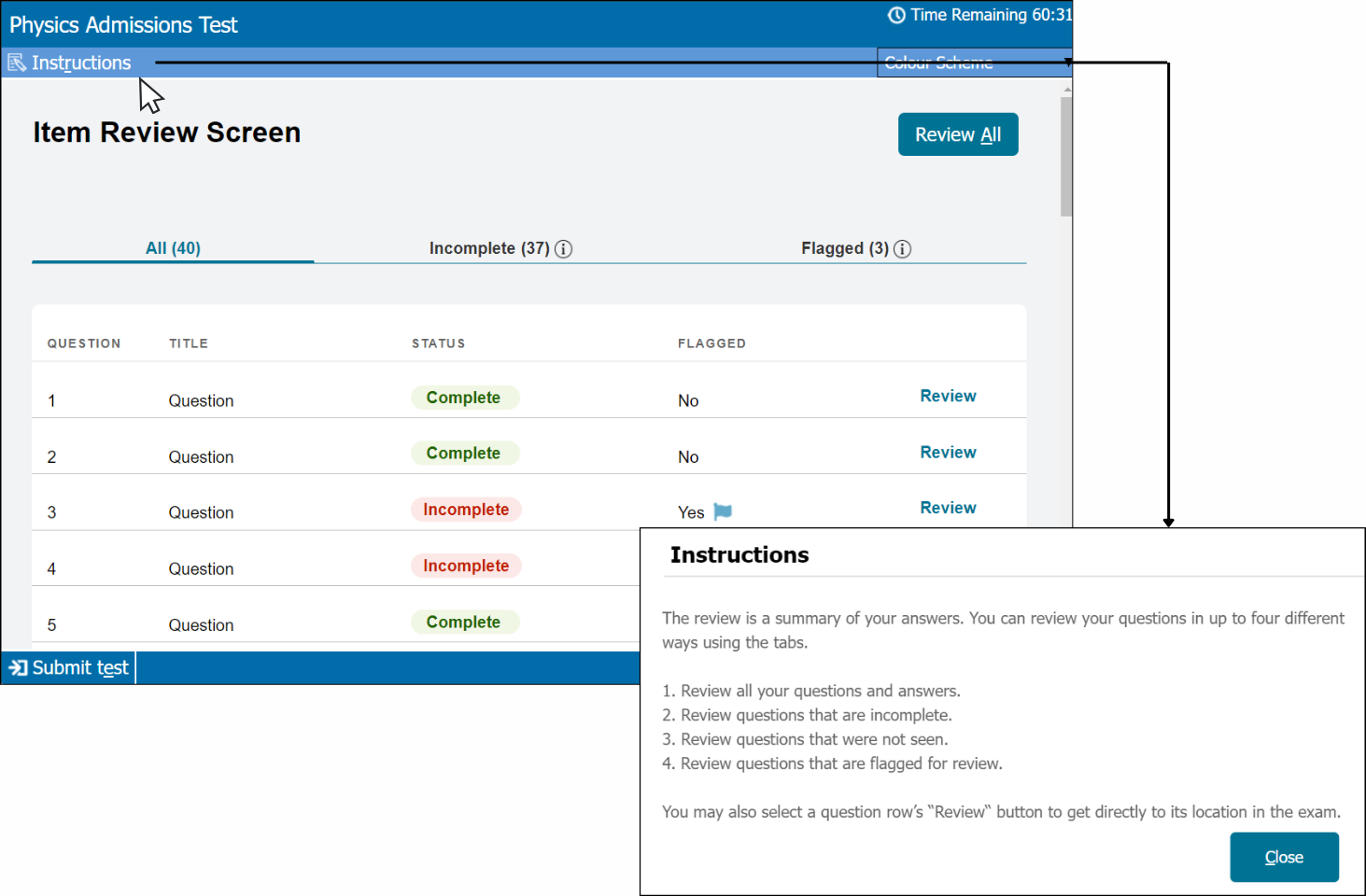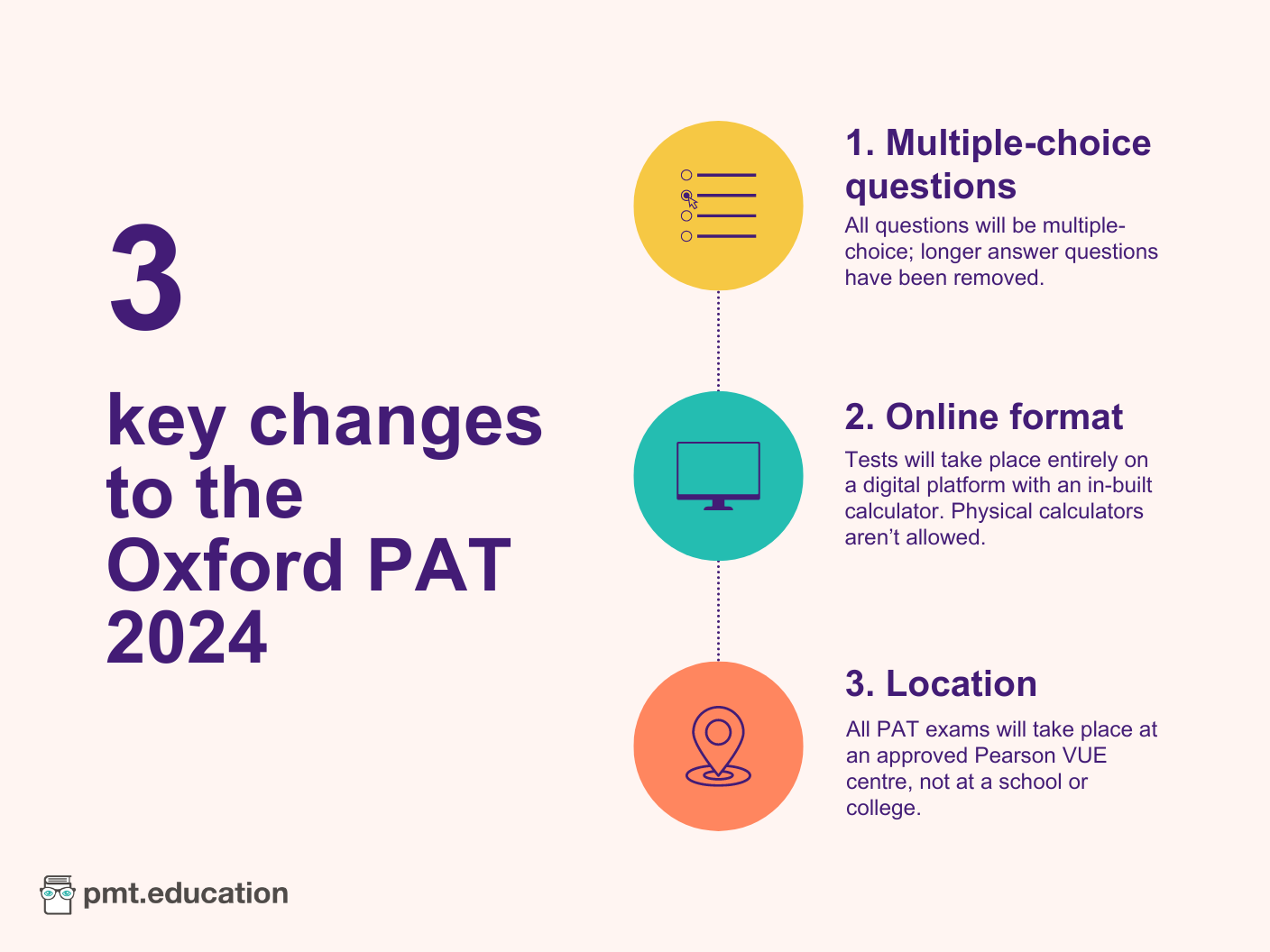Contents:
The Physics Aptitude Test (PAT) is the admissions test used by the University of Oxford for entry into their Physics, Physics and Philosophy, Engineering Science, and Materials Science courses. With the 2024 exam date set for Monday 28th October, it’s important to be aware of the three key updates to the test format, location and administration.
This article will guide you through these changes to ensure you are ready to navigate the updated PAT and tackle it with confidence. If you are already familiar with these updates and are seeking general information and advice from an expert PAT tutor, check out Oxford PAT: Syllabus, exam tips, and calculator guide.
1. The new multiple-choice format
Oxford University has announced that the 2024 PAT exam will consist entirely of multiple-choice questions, marking a significant change in format. You will be provided with a whiteboard for rough working and written notes, but these will be erased and returned at the end of the exam. This means only the selected answers will be graded.
The exam will be scored out of 100 marks. Although the exact number of questions and the allocation of marks have not been officially disclosed, the 2024 PAT practice paper may offer some insight. It features 40 questions, interspersing maths and physics problems, with each question worth between 2 to 4 marks.
What does this change mean for me?
Since the PAT is positively marked (i.e. there are no penalties for incorrect answers) and only the final answers are graded, it’s crucial to put an answer down for every question. If you’re unsure, make an educated guess, flag it using the exam software (keep reading for information on using the digital interface), and move on.
The key to success in this new format is to practise multiple-choice questions extensively and find a strategy that suits you. Often, it’s best to solve the problem before looking at the options, especially for calculation-based questions. If your answer doesn’t match any of the given options, check your work or use the process of elimination to narrow down the choices. If your answer does match, it gives you confidence that you have arrived at the correct solution!

2. The 2024 online exam platform for the PAT
The 2024 PAT exam will be conducted entirely online, with all multiple-choice answers submitted through Pearson’s online platform. To ensure you’re comfortable with the format, the best preparation is to explore the 2024 Pearson VUE PAT practice test. The University of Oxford has confirmed that this practice test will closely reflect what you will see in the exam. Here’s a handy guide to help you navigate the platform:
Getting started
When you first log in, you will see the front page which provides instructions for the exam. Take your time to read these carefully and listen to any instructions given by the invigilators at the test centre. When you’re ready and the invigilators give the go-ahead, press the “Next” button. You will be prompted to accept a Non-Disclosure Agreement to confirm you will not share the contents of the test. Press “Yes” and the test will begin; press “No” and it will terminate, meaning you will not be able to proceed.
Navigating the question pages
Each page clearly displays the question, the answer options and the number of marks available. Select your answer and use the “Next” and “Previous” buttons in the bottom right-hand corner to navigate between questions. In the top right, you will see the time remaining and your current progress.
If needed, you can adjust the colour scheme for better visibility. This option is available before the test starts and throughout the exam, so you can set this up in advance and change it at any point during the test.
Below is an annotated screenshot of a question page:

The Oxford PAT digital calculator
You won’t be allowed to use a physical calculator during the exam. Instead, you will have access to an on-screen scientific calculator. Practise using the digital calculator beforehand to get comfortable with it. You can either click the buttons with a mouse or type using your keyboard.
Top tip
When solving physics problems, avoid using your calculator for intermediary steps. Instead, simplify the algebraic expression as much as possible before substituting numerical values. By keeping the expression in algebraic terms until the final step, you reduce the likelihood of calculation errors.
Check out our handy guide to using this calculator for the Oxford PAT 2024.
Flagging questions for review
If you encounter a question you can’t answer immediately, make an educated guess and click the “Flag for Review” option. This will allow you to easily find and revisit the question later on.
Reviewing and submitting your exam
When you reach the end of the exam, the review page will appear.

Here, you can review your answers and see clearly which questions you have completed, which remain unanswered, and which have been flagged for review. The “Review” button on the left lets you jump directly to any flagged or incomplete questions. After completing any final adjustments, you can return to the review section.
When you’re satisfied with your answers, click “Submit Test.” If you run out of time, the test will automatically end and your answers will be saved and submitted. Follow all on-screen instructions and any guidance from the invigilators when ending the test.
While this guide provides an overview, it’s essential to practise using the online platform yourself to become fully comfortable with it before exam day.
3. Transition to Pearson VUE test centres
From 2024, the PAT will take place at Pearson VUE test centres instead of schools or colleges. Registration must take place between Thursday 15th August and Friday 4th October, but Oxford strongly recommends completing this as early as possible. The registration process is free of charge.
For information on how to register and book your PAT test, refer to Oxford’s step-by-step registration guide. Pearson VUE also offers an over-the-phone registration service for those who need assistance, though online registration is preferred.
Do you require access arrangements?
If you need access arrangements or accommodations, you can request these when booking your test. You will need to provide evidence of your needs, typically by uploading the necessary documents.
During registration, you will be asked for your UCAS ID. If you haven’t submitted your UCAS application yet, you can still book the test but must add your UCAS ID as soon as possible. This will be used to match your test with your UCAS application.
What to expect on the day of your PAT 2024
Test day at a Pearson VUE centre will likely feel somewhat familiar if you’ve taken an exam at a test centre before. If not, don’t stress. There will be plenty of staff to help you on the day, and here we’ll explore what you can expect.
Check-in
Punctuality is crucial. Ensure you leave plenty of time to arrive. If you are more than 15 minutes late, you may not be permitted to take the exam. You must bring a valid form of ID; if you don’t have one, your school or college can confirm your identity with a letter. Without a valid ID, you won’t be able to sit the test.
During check-in, you will need to read and sign the Pearson VUE Candidate Rules Agreement, confirming that you have understood the guidelines. We recommend reviewing this agreement before exam day.
The test administrator may conduct additional checks, such as asking you to turn out your pockets or roll up your sleeves. Your photograph will also be taken. If it would make you more comfortable, you can request to do this in a private area.
Personal belongings
You’re not allowed to bring anything into the exam room except your ID and any pre-approved comfort aids or necessary items (you should confirm these arrangements beforehand). All other personal belongings must be stored in a locker.
Entering the test room
The test room will be equipped with computers, each separated by partitions to ensure privacy. Invigilators will monitor the room either directly or via CCTV. As with all exams, stay quiet, keep your focus on your screen, and raise your hand if you need to speak to an invigilator, including when you’ve finished the test.
While this might seem like a lot to take in, don’t worry – it will all be explained to you again on the day of your exam. By preparing ahead of time, you can ensure a smooth experience and focus on performing your best.

What has remained the same for the PAT 2024?
While the format of the PAT has shifted to an entirely online, multiple-choice exam, its core purpose remains unchanged: to assess your problem-solving abilities and readiness for Oxford’s rigorous physics, engineering, and related courses. Despite the format update, several key aspects of the PAT will stay the same.
Content
The PAT syllabus is largely based on GCSE and AS Level Physics and Maths, but some topics such as circular motion may not have been covered yet. Therefore, you should review the syllabus thoroughly and consider reading ahead to cover any unfamiliar material. Your teacher should be able to guide you on what will be covered before the exam.
Question focus
The questions are designed to assess your problem-solving skills, which differ from the more straightforward approaches you might encounter in A Level exams. The PAT challenges you to think critically and apply your knowledge in novel ways.
Admissions process
The overall admissions process remains the same. After the PAT, shortlisted candidates will be invited for interviews as part of the next stage in the selection process.
Preparation
Although the format has changed, preparation remains important. PAT past papers are still highly valuable as they reflect the style and level of difficulty of the questions. Additionally, resources like the British Physics Olympiad and Isaac Physics offer similar problem-solving challenges that can help hone your skills – just remember to put extra focus on practising multiple-choice questions.
Oxford PAT 2024 summary: The 3 key changes
A lot has been covered here, so to keep things simple, here is a summary of the three key changes to the PAT that you need to know:

With any new exam format, there’s always the possibility of surprises. At the start of the exam, take a moment to carefully read the instructions. If the exam seems different to what you expected, stay calm, take a deep breath and think logically. If anything isn’t clear on the day, ask for clarification. Most importantly, go in with an open mind and give it your best shot. Good luck!
For more information and advice from our expert PAT tutor, Natalie, read this comprehensive guide to succeeding in the Oxford PAT.








Comments